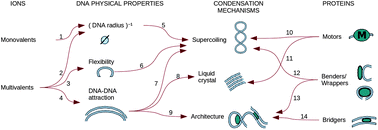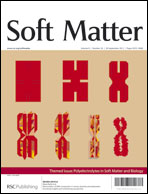Electrostatics of DNA compaction in viruses, bacteria and eukaryotes: functional insights and evolutionary perspective
Abstract
The molecular support of genetic information, DNA, has to be packaged and organized inside the tiny volume of nuclei, cells, or virus capsids, in an ordered and dynamical way. Evolution has favored different strategies in different kingdoms: a liquid crystal ordering mechanism prevails in viruses; strong entanglement due to supercoiling is the main compacting strategy in bacteria; the building of a hierarchical and tunable architecture mediated by DNA–protein interaction constitutes the main compacting mechanism in archaea and eukaryotes. The interplay between these different strategies is however much more complex than at first sight and all these strategies can be used in a synergistic way. All of them have to deal with the same elementary physical constraint which hinders compaction: electrostatic repulsion due to the high line charge density of DNA. In this review, we will show how this apparent weakness can be turned into a strength in order to compact this long molecule in a functional way.

- This article is part of the themed collection: Polyelectrolytes in Soft Matter and Biology

 Please wait while we load your content...
Please wait while we load your content...